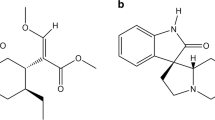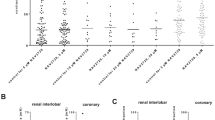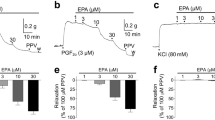Abstract.
Vasodilator responses to anandamide (arachidonylethanolamide) and potassium ions were compared with those mediated by endothelium-derived hyperpolarizing factor (EDHF) in guinea-pig isolated basilar artery contracted with prostaglandin F2 α. In this artery, EDHF-mediated responses can be evoked by acetylcholine in the presence of both indomethacin (10 µM) and N G-nitro-l-arginine (0.3 mM). In endothelium-denuded arterial segments, which failed to respond to acetylcholine, anandamide was still able to evoke a complete relaxation. Anandamide (10 µM) did not affect the resting membrane potential, whereas acetylcholine (10 µM) hyperpolarized the smooth muscle cells by 23 mV in the presence of indomethacin and N G-nitro-l-arginine. Pre-treatment with capsaicin (10 µM) or resiniferatoxin (0.1 µM) abolished the anandamide-induced relaxation, but had no effect on the EDHF-mediated relaxation induced by acetylcholine. Treatment with a mixture of the calcium-sensitive potassium channel inhibitors, apamin and charybdotoxin, which abolishes EDHF-mediated relaxation in this artery, did not affect the relaxation evoked by anandamide. The additional presence of glibenclamide or ciclazindol, inhibitors of ATP-sensitive and voltage-dependent potassium channels, also had no effect on the anandamide-induced relaxation. Increasing the potassium ion concentration by 2–10 mM induced inconsistent vasodilator responses. However, re-admission of potassium ions to preparations incubated in potassium-free solution elicited almost complete and sustained relaxations. A short incubation period with ouabain (10 µM for 10 min) or cooling (18–22°C) abolished these responses, whereas the acetylcholine-induced relaxation in the presence of indomethacin and N G-nitro-l-arginine was unaffected (ouabain) or partially reduced (cooling). The anandamide-induced relaxation was also abolished by ouabain and cooling. Furthermore, ouabain inhibited the vasodilator response to capsaicin, but not that to calcitonin gene-related peptide (CGRP), and per se evoked a release of CGRP from the artery. The gap junction uncoupler, 18α-glycyrrhetinic acid (100 µM), affected neither the EDHF-mediated relaxation induced by acetylcholine nor the vasodilator responses to anandamide and potassium ions. Thus, EDHF-mediated vasorelaxation in the guinea-pig basilar artery does not seem to involve Na+/K+-ATPase, sensory nerves or gap junctions. These results indicate that EDHF is neither anandamide nor potassium ions in this artery.
Similar content being viewed by others
Author information
Authors and Affiliations
Additional information
Electronic Publication
Rights and permissions
About this article
Cite this article
Zygmunt, P., Sørgård, M., Petersson, J. et al. Differential actions of anandamide, potassium ions and endothelium-derived hyperpolarizing factor in guinea-pig basilar artery. Naunyn-Schmied Arch Pharmacol 361, 535–542 (2000). https://doi.org/10.1007/s002100000229
Received:
Accepted:
Issue Date:
DOI: https://doi.org/10.1007/s002100000229




